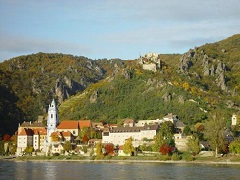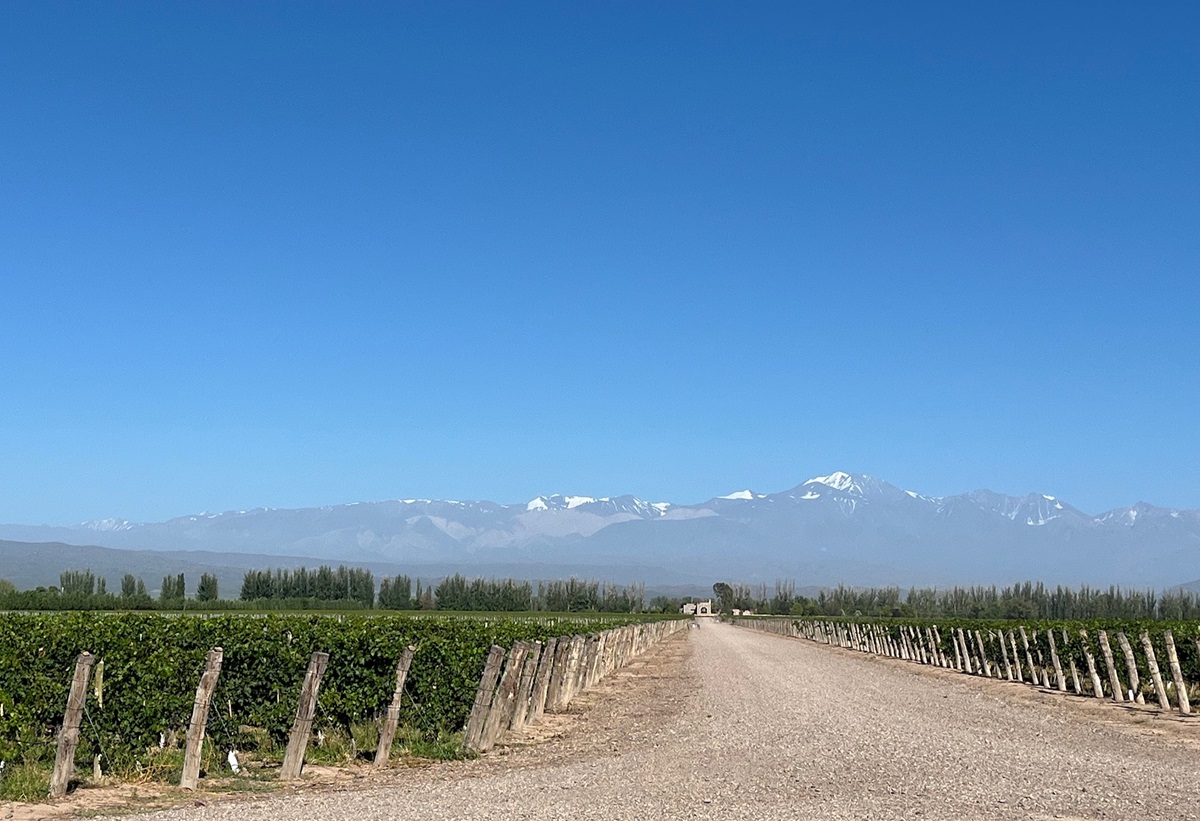DOWN THE DANUBE

By Rose Murray Brown MW Published in The Scotsman 2 April 2016
Europe’s second longest river, the Danube, flows through ten different countries. All of these countries have vineyards alongside the river valley – although we only see wine from seven of these countries on our shelves in the UK: Germany, Austria, Croatia, Hungary, Bulgaria, Romania and Republic of Moldova.
A trip down this famous river is a fascinating vinous adventure. We begin at its source in Germany, head through Central and Eastern Europe on to the Danube Delta where the river meets the Black Sea near Moldova and Ukraine – some 1,770 miles later. We have picked out a selection of the best wines from wine regions which benefit from the special microclimate of the Danube Plains and valley along the way.
GERMANY
The Danube rises near the Black Forest in Donaueschingen village where two rivers Breg and Brigach (pictured below right) form the Danube in south-west Germany. Nearby is the famous wine region of Baden, with its famous Kaiserstuhl limestone and volcanic soils. The white and red wines show great similarities to Burgundy in style and weight, so they tend to be more typical of French, rather than German wines.
 RECOMMENDED WINE: Baden, SW Germany: Kaiserstuhl Pinot Noir 2012 Karl H Johner
RECOMMENDED WINE: Baden, SW Germany: Kaiserstuhl Pinot Noir 2012 Karl H Johner
(£13.95 The Wine Society www.thewinesociety.com)
Style: Medium Bodied Red
Alcohol: 13.5%
Well priced German Pinot Noir: vibrant fresh with sweet cherry fruits. Karl Johner is very experienced Pinot Noir winemaker, he also has a vineyard in Gladstone in Wairarapa region in New Zealand’s North Island.
AUSTRIA
Heading through Austria, the fast flowing Danube cuts through narrow valleys with steep forested banks. The best vineyards here hug the river on steep terraces on the northern banks in Wachau region – and on the southern banks in Kremstal and Traisental. One of the most popular grapes grown in all these regions of the lower Danube valley is the lightly spiced Gruner Veltliner.
 RECOMMENDED WINE: Traisental, Austria: Taste the Difference Gruner Veltliner 2014 Markus Huber
RECOMMENDED WINE: Traisental, Austria: Taste the Difference Gruner Veltliner 2014 Markus Huber
(£7 reduced from £8 bt at Sainsbury’s until 5 April)
Style: Dry White
Alcohol: 12.5%
The best value Gruner Veltliner on the market: light spice, herbal, citric, vibrant minerally dry white.
HUNGARY
After flowing through the Hungarian Gates near Bratislava, the Danube heads down through the centre of Hungary. Half of Hungary’s wines are produced south of the capital Budapest in the Danube Plains – the best known is Kunsag region with its charmingly light aromatic dry whites.
 RECOMMENDED WINE: Kunsag, Hungary: Cserszegi Fuszeres 2014 Frittmann Testverk
RECOMMENDED WINE: Kunsag, Hungary: Cserszegi Fuszeres 2014 Frittmann Testverk
(£9.95 Berry Bros & Rudd www.bbr.com) ***STAR VALUE BUY***
Style: Dry White
Alcohol: 12%
Reminds me of a dry Muscat with its grapey floral aromas, light spicy palate, fresh and brilliant value – typical of what Hungary does so well.
CROATIA
Slavonia wine region in eastern Croatia, south east of capital Zagreb, benefits from the Danube river microclimate. Slavonia is well known for the Grasevina grape (otherwise known as Welshriesling) where it produces its richest fullest styles, as well as home to the famous Slavonian oak forests used to make wine barrels.
 RECOMMENDED WINE: Slavonia, Eastern Croatia: Grasevina 2013 Ilocki Podrumi
RECOMMENDED WINE: Slavonia, Eastern Croatia: Grasevina 2013 Ilocki Podrumi
(£12.90 Croatian Fine Wines www.croatianfinewines.com)
Style: Dry white
Alcohol: 13.5%
Very elegant creamy rounded example of Grasevina grape; would suit white Burgundy lovers.
BULGARIA
In the middle and lower courses, the Danube becomes shallower, slower and more like a flat-bed river – at its widest almost a mile wide – with marshy banks and low terraces. Just to the south of the river is the experimental Borovitza winery near Vidin in northern Bulgaria.
 RECOMMENDED WINE: Danube Plains, Bulgaria: Gamza Black Pack 2013 Borovitza
RECOMMENDED WINE: Danube Plains, Bulgaria: Gamza Black Pack 2013 Borovitza
(£10.95 The Wine Society www.thewinesociety.com)
Style: Medium bodied red
Alcohol: 13%
The Gamza grape, also known as Kadarka in nearby Hungary, makes deliciously juicy Beaujolais-style reds: very sweet cherry fruits, chunky red fruit palate, tangy with good length.
ROMANIA
Romania has a vast number of vineyards (more than Australia), many of which are based between the northern banks of the Danube in Romania and the southern slopes of the Carpathian mountains. With its strong French influence, there are plenty of Chardonnays and Pinot Noirs here – but the native Feteasca Neagra red grape is very characterful.
 RECOMMENDED WINE: Dealu Mare, Romania: Feteasca Neagra 2012 Crama Ceptura
RECOMMENDED WINE: Dealu Mare, Romania: Feteasca Neagra 2012 Crama Ceptura
(£8.95 Berry Bros & Rudd www.bbr.com) ***STAR VALUE BUY***
Style: Full bodied red
Alcohol: 13.5%
This was hugely popular at our recent tasting: crunchy red fruits, smoky undertones, herby but vibrantly fresh red. Suit Merlot drinkers.
REPUBLIC OF MOLDOVA
Viticulture is Moldova’s main agriculture along the lower Danube plains. Whilst there is huge potential: with similar latitude to Burgundy, poor soils and moderate continental climate tempered by both the Danube Delta (pictured right) and the Black Sea, international investments have been limited due to its proximity to Ukraine and Russian borders. Moldova once supplied one fifth of Russia’s needs and has the dubious claim to fame of having the highest alcohol consumption in the world. At its best with fullbodied claret style reds and sensational dessert ice wine.
 RECOMMENDED WINE: Republic of Moldova: Negru du Purcari 2010
RECOMMENDED WINE: Republic of Moldova: Negru du Purcari 2010
(£18.95 Berry Bros & Rudd www.bbr.com)
Style: Full bodied red
Alcohol: 14%
Remarkably good Cabernet Sauvignon-dominant blend with a little Saperavi and Rara Neagra grapes matured in French oak. It tastes like a cross between claret and northern Rhone. Fascinatingly spicy red which shows what potential Moldova has.
Join Rose’s Taste of Scotland Food & Wine Masterclass on Friday 1 July in Abode Hotel, Bath Street, Glasgow £40: www.rosemurraybrown.com
wine tastings
The perfect gift for the wine enthusiast in the family. Rose does In-person tastings too.
cellar advice
Rose does cellar valuations for private clients, valuations for insurers & bespoke portfolio management.
Related stories
March 31, 2024
By Rose Murray Brown MW Published in The Scotsman 30 March 2024 On 2 February 1659, the first wine made from grapes grown in South Africa was crafted by the Governor of the Cape, Jan van Riebeeck. He had planted vines four years earlier in the Company’s Garden near Cape Town from cuttings imported from France. Van Riebeeck’s first
March 24, 2024
By Rose Murray Brown MW Published in The Scotsman 16 March 2024 Heatwaves and bushfires were very much on the agenda when I visited Chile last month as winemakers prepared for their 2024 harvest in blistering heat and drought, with a plume of smoke from the devastating fires lingering over coastal hills. Heat and drought are the greatest challenges
March 23, 2024
By Rose Murray Brown MW Published in The Scotsman 9 March 2024 I have two glasses of Malbec in my hands from the same high-altitude vineyard in Uco valley in Argentina. I am in the Catena Institute of Wine in Mendoza with winemaker Agustin Silva. He has asked me to taste the two wines, both from the 1500m high



